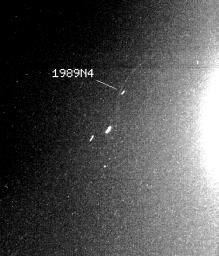
|
Neptune - Partial Rings
- Click the image above for a larger view
- Full-Res JPEG (373 x 438) (47.5 kB)
- Full-Res TIFF (373 x 438) (48.1 kB)
Caption:
One of two new ring arcs, or partial rings, discovered today by NASA's Voyager 2 spacecraft, is faintly visible here just outside the orbit of the Neptunian moon 1989N4, also discovered by Voyager 2 earlier this month. The 155 second exposure taken by Voyager's narrow-angle camera shows the glare of an overexposed Neptune to the right of the moon and ring arc. The two bright streaks below the moon and ring arc are stars. The ring arc is approximately 50,000 kilometers (or 30,000 miles) long. (The second ring arc, not apparent here, is approximately 10,000 kilometers (6,000 miles) long and is associated with the moon 1989N3.) The ring arc, along with 1989N4, orbits about 62,000 kilometers (38,000 miles) from the planet's center, or about 37,000 kilometers (23,000 miles) from the planet's cloud tops. Astronomers have long suspected the existence of such an irregular ring system around Neptune. Data from repeated ground based observations hinted at the existence of irregular strands of partial rings orbiting Neptune. Voyager's photographs of the ring arcs are the first photographic evidence that such a ring system exists. Voyager scientists said the ring arcs may be comprised of debris associated with the nearby moons, or may be the remnants of moons that have been torn apart or ground down through collisions. Close-up studies of the ring arcs by Voyager 2 in coming days should help determine their composition.
Background Info:
The Voyager mission is conducted by the Jet Propulsion Laboratory for NASA's Office of Space Science and Applications.
Cataloging Keywords:
| Name | Value | Additional Values |
|---|---|---|
| Target | Neptune | Neptune Rings |
| System | Neptune | |
| Target Type | Planet | Ring |
| Mission | Voyager | |
| Instrument Host | Cassini Orbiter | Voyager 2 |
| Host Type | Orbiter | Flyby Spacecraft |
| Instrument | Imaging Science Subsystem (ISS) | |
| Detector | Narrow Angle Camera | |
| Extra Keywords | Collision, Disk, Grayscale, Visual | |
| Acquisition Date | ||
| Release Date | 1999-07-25 | |
| Date in Caption | ||
| Image Credit | NASA/JPL | |
| Source | photojournal.jpl.nasa.gov/catalog/PIA02200 | |
| Identifier | PIA02200 | |
